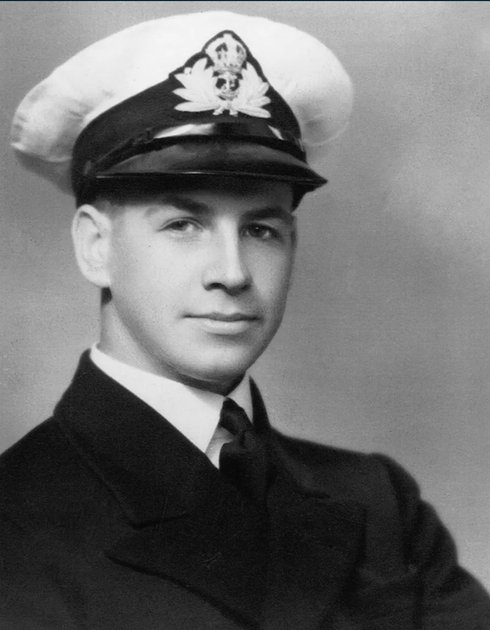Lieutenant Commander Kenneth Hudspeth
Lieutenant Commander Kenneth Robert Hudspeth DSC** RAN

Image provided by Royal Australian Navy
Born in Echuca, Victoria, in 1918 but raised in Tasmania, Kenneth Robert Hudspeth developed physical fitness and a love of the sea from the earliest age; revelling in bush walking, a wide range of activities as a Sea Scout and as a sailor.
Following the outbreak of war, Hudspeth joined the Navy and was appointed as a probationary Sub-Lieutenant, RANVR on 15 July 1940. His first posting was HMAS Cerberus for induction, followed by HMAS Rushcutter for anti-submarine warfare training.
Hudspeth left Australia in the MV Imperial Star in January 1941. Arriving in the UK in late March, he was assigned briefly in the Flower class corvette HMS Clarkia before serving for the next 18 months on convoy escort duties in the North Atlantic aboard the corvette HMS Anemone.
But it was in mid-1942 that his true calling emerged after a somewhat mysterious appeal for volunteers for “special and hazardous service”. With no specific details of the actual duties, applicants were told only that they must be; “below 24 years of age on selection, unmarried, be good swimmers and of strong and enduring physique”. Hudspeth was accepted and posted to HMS Varbel, on the Isle of Bute, where he commenced training in the new British midget submarines known as X-Craft. He was promoted Lieutenant on 15 January 1943 and was appointed commanding officer of HMS X-10.
The first major employment of the X-Craft was Operation SOURCE involving attacks on the German warships Tirpitz, Scharnhorst and Lutzow, then operating from northern Norwegian Fjords where they posed a major threat to Allied convoys.
Hudspeth was awarded a Distinguished Service Cross (DSC). His citation read, in part; “for outstanding courage whilst in command of HM Submarine X10 during Operation Source in September 1943. This submarine penetrated Alten Fjord on 22 September 1943 to within four miles of where Tirpitz was lying. Lieutenant Hudspeth bottomed in this position in enemy waters throughout 22 September while he and his crew worked in trying conditions to make good the vessel’s defects. The attempt was in vain and Lieutenant Hudspeth had to come to the correct though bitter decision to withdraw, when so near his goal. The successful double passage of the approaches to Alten Fjord required determination and skill of a high order. The information this officer was able to bring back was of great value”.
Upon return to Varbel, the surviving X-Craft crews began training for Operation POSTAGE ABLE. Early planning for the invasion of Europe showed crucial gaps in Allied knowledge of the Normandy coastline. X-Craft were to deliver specialist commandos to the proposed invasion beaches, then recover them once they had obtained vital information such as beach gradient, sand and soil consistency (to support vehicles coming ashore) tides and rips, hazards (both man-made and natural) and enemy defences.
Hudspeth and his crew from X-10 were re-assigned to a new vessel X-20 where, during the period 17-21 January 1944, they landed and retrieved commandos in the area that would become Omaha and Utah Beaches.
Lieutenant Hudspeth was awarded a Bar to his DSC for the action. The citation read, in part; “for outstanding courage and devotion to duty in hazardous operations. He showed great coolness, grasp and ability in manoeuvring his X-Craft submerged in shallow water close under enemy defences.”
During Operation GAMBIT, between 2 - 6 June 1944, Hudspeth again commanded X-20, acting as navigation beacons for landing-craft heading towards the Normandy beaches. At 0500 on 6 June 1944, X-20 raised her periscope, along with the telescopic mast that had the navigations lights affixed and waited for the invasion of Europe to begin. This was the most dangerous period. Not only was the X-20 in danger of being hit by German artillery fire aimed at the approaching Allied fleet, but also of being run down by incoming Allied vessels. For his service in the D-Day operations Hudspeth was awarded a second Bar to his DSC; “for gallantry, skill, determination and undaunted devotion to duty.”
Hudspeth then returned to Varbel where he trained new X-Craft crews and updated the vessel's training manuals. In September 1944 he was appointed to the destroyer HMS Orwell as an Anti-Submarine Officer. Orwell re-joined the Home Fleet in May 1945 and Hudspeth became her First Lieutenant (second in command).
Arriving home in Tasmania in early December 1945, Hudspeth was demobilised, but later re-joined the RAN Reserve and was promoted Lieutenant Commander. He eventually resigned from the RAN Reserve in 1965.
After the war, Hudspeth returned to his pre-war occupation as a teacher, serving as the warden of “Werndee”, a hostel in Hobart for junior and trainee teachers, Principal of the Teachers Training College, Superintendent of Education Department Buildings throughout Tasmania, and President of the Teachers Federation of Australia.
In 1959 he married English-born Audrey Nicholson whom he had first met while on leave in the United Kingdom during the war. They later had three sons; Andrew, David and Donald.
Hudspeth retired in 1979. While he enjoyed music and literature, his passion remained anything nautical and he was heavily involved with the Tasmanian Maritime Museum and the preservation of Hobart’s rich maritime history.
Kenneth Robert Hudspeth died in Hobart on 3 December 2000.